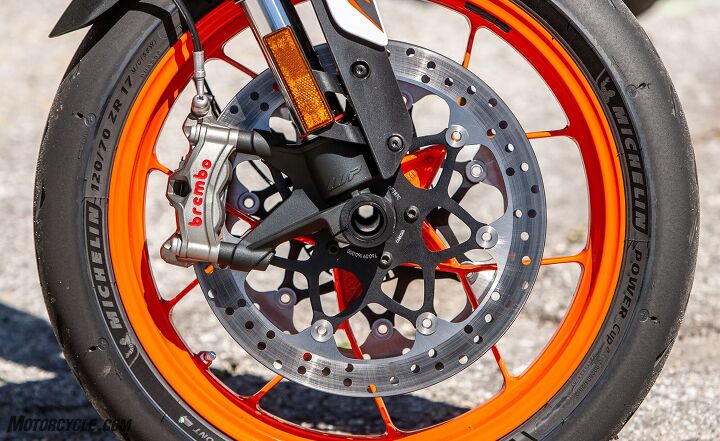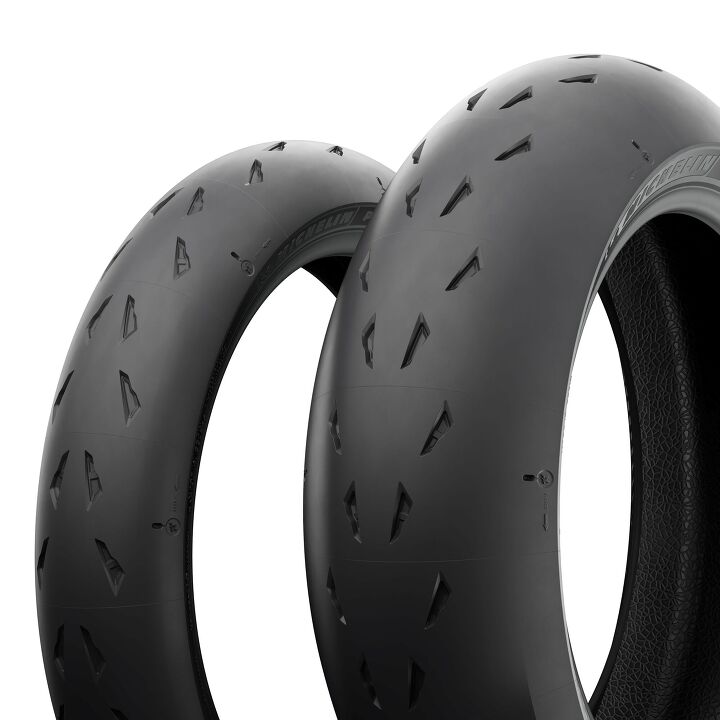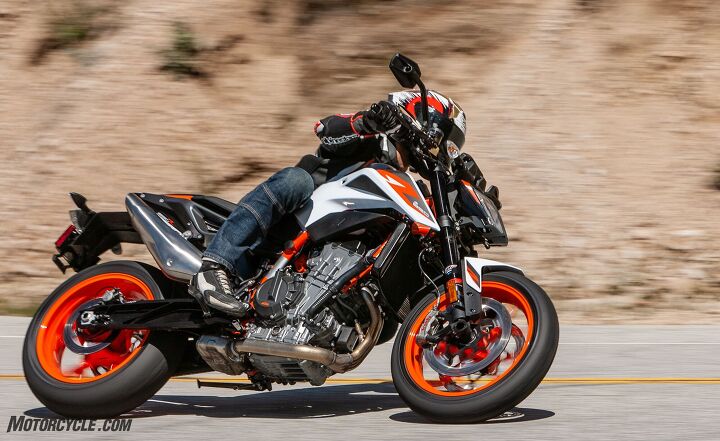Motorsports Racing News & Blog Articles
MO (Track) Tested: Michelin Power Cup 2 Tires
Tire manufacturers are getting bold these days, pumping out tires that barely pass the bar for what counts as street legal. Take the Michelin Power Cup 2, for example. If it weren’t for the scant traces of tread marks down the middle, you could easily mistake these tires for a racing slick. And with a 5% void ratio, clearly, that’s the point. Michelin also goes so far as to outright claim the Power Cup 2 as a 90/10 tire – that is, it’s made to spend 90% of its time on track and 10% on the street. The slight tread profile proves just enough for the Department of Transportation to deem it legal for use on public roads. With that endorsement, KTM – you know, being “Ready To Race and all – have even found it fitting to slap the Power Cup 2 tires on the 890 Duke R – stock!

The aggressiveness of the Power Cup 2 fits right in with KTM’s company ethos. It’s no wonder it’s the stock fitment on the 890 Duke R.
Michelin isn’t the only one making nearly track-only tires, of course. Pirelli first introduced its Supercorsa TD (or Track Day) tire, but now has incorporated those compounds as its SC3 variety. On the Dunlop side, the Q3+ and Q4 tires also fill the street-legal trackday tire void. Pirelli’s sister brand Metzeler has a full-on slick tire with the TD moniker attached to it. Street legal it is not, but track-focused without the need for tire warmers it most definitely is.
Having tried all those previous tires on track before, it’s a little embarrassing it’s taken me this long to finally give the Michelin Power Cup 2 tires a go. The wait was worth it, however, because these tires really did impress. More on that later. First, let’s get down to the nitty-gritty.
What’s Inside
 Because it is a street-legal tire that can also handle significant track duty, the Power Cup 2 has to be able to warm up quickly without warmers. The key to getting a tire warm is flexion of the carcass to create heat. More and more, makers of track tires are making soft and flexible sidewalls for just this reason, including Michelin. This was clear from the moment we spooned the tires onto our 2021 Yamaha MT-09 SP test bike – our hands basically sunk into the tire sidewall as we pressed it on. That alone was a sign we were on to something good.
Because it is a street-legal tire that can also handle significant track duty, the Power Cup 2 has to be able to warm up quickly without warmers. The key to getting a tire warm is flexion of the carcass to create heat. More and more, makers of track tires are making soft and flexible sidewalls for just this reason, including Michelin. This was clear from the moment we spooned the tires onto our 2021 Yamaha MT-09 SP test bike – our hands basically sunk into the tire sidewall as we pressed it on. That alone was a sign we were on to something good.
Traditionally, apart from a tire having to be flexible to generate heat, the compounds used in the tire have to be able to make the tire work in a variety of conditions. Silica is the popular compound in street tires that lets them work as intended in a variety of weather conditions. It’s usually combined with carbon black, which is what gives a track tire its grippiness.
For the Power Cup 2, Michelin’s 2CT and 2CT+ technologies have allowed it to place different compounds in different areas for maximum traction on the sides and max longevity down the middle. In the Power Cup 2’s case, the front tire sees carbon black make up 38% of the sides and 24% of the middle compound. The rear has a 36% carbon black makeup on the sides and 28% down the middle. The rest of the compound is mostly silica, and the combination of the chemical makeup and soft sidewall construction is why Michelin says you don’t have to use tire warmers to get the Power Cup 2s up to operating temperature quickly.

The minimal tread and huge sections of uninterrupted rubber along the sides give huge amounts of grip, and makes the Department of Transportation happy.
What’s more, the Power Cup 2’s neutral profile, and availability in many of the same sizes as what most sportbikes come with standard, means you’ll only need to make minimal changes to your bike’s settings, if any, to achieve optimal handling.
The Track Test
Here’s an admission: As it says in the title of this piece, this is a track test of the Michelin Power Cup 2 tires. Originally the idea was just to test the Yamaha it was spooned on and call it good. But it was such an impressive tire the thought of giving it a dedicated track review seemed warranted.

Having previously sampled the Power Cup 2 on the streets aboard the KTM 890 Duke R, its street performance is no less impressive than its track showing.
That said, I’ve spent time with the tires on the road while riding the KTM 890 Duke R and came away very impressed with its street manners. However, my time with the Duke was during warmer months, and I’d still be very cautious about pushing these tires hard on the streets on a cold day. Then again, that’s basically true for most tires.
As it were, Chuckwalla Valley Raceway proved to be an excellent venue to put the Power Cup 2s to the test, as most of its corners are long, flowing affairs. There’s not much point-and-shoot here. Chuckwalla’s layout would test stability and grip while leaned over for extended periods of time, and the rear’s ability to drive out of corners would also be put to the test.

Pulling up to a race practice trackday with a stock Yamaha MT-09 SP could seem a little intimidating, but the Power Cup 2 tires helped me push the bike to levels that left me feeling comfortable surrounded by race bikes.
I did run warmers for most of the day, but soon realized I didn’t have to. After stopping to chat with other riders, vendors, and friends between my pit space and the track entrance my tires had cooled significantly. All it took was a solid lap of hard braking and acceleration while completely upright to generate enough heat to establish the confidence I needed to push.
 And while the ease at which the tires got up to temperature was impressive, the neutral profile of the tires – the front especially – was another highlight. It felt like there was a 1-to-1 connection between my lean angle inputs and how far the tire would lean over. Once I started to add slight brake pressure to the lean angle, the soft sidewall always felt like it was connected to the ground. The one time it wasn’t was while applying brakes and starting my lean over a slightly bumpy part of the track. As the fork had a hard time dealing with the braking forces and bump absorption, the front began an oscillation only cured by relieving brake pressure. This really has nothing to do with the tire, but despite the fork having issues, the rubber left me confident it was still up to the task of trailbraking into the corner.
And while the ease at which the tires got up to temperature was impressive, the neutral profile of the tires – the front especially – was another highlight. It felt like there was a 1-to-1 connection between my lean angle inputs and how far the tire would lean over. Once I started to add slight brake pressure to the lean angle, the soft sidewall always felt like it was connected to the ground. The one time it wasn’t was while applying brakes and starting my lean over a slightly bumpy part of the track. As the fork had a hard time dealing with the braking forces and bump absorption, the front began an oscillation only cured by relieving brake pressure. This really has nothing to do with the tire, but despite the fork having issues, the rubber left me confident it was still up to the task of trailbraking into the corner.
Since the Power Cup 2 is essentially a slick once on its side, ultimate grip while leaned over left very little to be desired. Despite riding a bone stock street bike during a trackday meant to give racers practice before the upcoming race weekend, the MT-09 SP and Power Cup 2 combo were giving 600cc supersport riders fits all around Chuckwalla’s sweeping turns. Their horsepower advantage ultimately got the better of me. But through the turns? A lot of them had to stare at my turn signals…

Great edge grip, neutral profile, and good communication throughout the day – the Power Cup 2 is impressive. And look at that wear! This photo was taken after a full day of track abuse. It nearly looks new!
As far as the rear goes, I don’t have much to complain about. No matter how greedy I got with the throttle, the rear PC2 never got out of step. I had traction control down to its lowest setting, and since these systems have become so sophisticated if TC was working to save my bacon, I didn’t notice it.
As I browse various forums and see other people’s thoughts about the Power Cup 2, it seems the only mixed reaction is in regards to the tire’s longevity. Some say they chew through theirs within one trackday, while others have gotten through three-plus, with plenty of street miles in between. Much of a tire’s life will depend on riding conditions, pavement conditions, and suspension settings, but as you can see from the picture to the right of my rear tire after the day was done, the wear looks beautiful. I wouldn’t hesitate to use it again for another trackday (or two).
Sticky-Icky
Am I impressed with the Power Cup 2? Absolutely. A soft and sticky tire is always a nice treat to have when bombing around a race track, but the fact it can also pull double duty and hustle through a canyon run is a nice bonus. It’s weird to say this as I don’t feel that old, but I can remember a time when the tires I used for the track would be heat-cycled to death by the end of the day and be hard as a rock if I tried to ride on the street the next day. This is called progress, folks, and we’re all the better for it.
Inevitably though, there is still no do-it-all tire. When you look at the minimal tread on the Power Cup 2, the huge slick sections, and its preference to be ridden hard at a hot track, that leaves very little margin for this tire to be used in adverse conditions. Also, the tradeoff between grip and durability remains, and though I haven’t worked a Power Cup 2 down to the cords, common knowledge is that sticky track tires don’t make great touring tires. There’s no reason to believe the Power Cup 2s would be the rubber of choice for a cross-country tour.
Then again, if you’ve read this far it’s because you’re not looking to tour. You want something gooey for your fire-breathing sportbike (or sporty bike) to conquer both the racetrack and the canyons with. And unless you’re racing and want slicks, the Michelin Power Cup 2 is easily in the ranks of awesome multipurpose track/street tire.
| Michelin Power Cup 2 | |
| + Highs Quick warm-up times Phenomenal grip Seemingly impressive longevity | – Sighs Not a touring tire (duh) Size choices are limited ??? |
Shop for the Michelin Power Cup 2 here
FAQ
How long do motorcycle tires last?
That depends on a lot of factors: what kind of tire? What bike? What type of riding? What conditions will you be riding in? Since this is a review of a track-focused tire, we’ll cater the answer to this category. Track tires need to offer the maximum amount of grip possible. This means the tire will be soft. A soft tire typically doesn’t last very long. It’s not uncommon for aggressive track riders or racers to chew through a set of tires in one weekend. Others can get several trackdays, or a couple thousand street miles out of them. As always, your mileage may vary.
What are the best motorcycle tires for grip?
If all you care about is maximum grip, a track tire is the one you should choose. See the question above. Track tires focus on grip at nearly all costs. Each tire manufacturer that produces a track-focused tire employ all the latest innovations their engineers can think of into track tires, with the intent of passing that tech down the line to other tires in their respective portfolios.
Are track tires good?
Man, Google asks some weird questions. Yes, of course track tires are good – that’s kinda the point.
Related Reading
MO Tested: Pirelli Supercorsa TD Review
Dunlop Sportmax Q3+ Tire Review
The post MO (Track) Tested: Michelin Power Cup 2 Tires appeared first on Motorcycle.com.
Copyright
© Motorcycle.com


